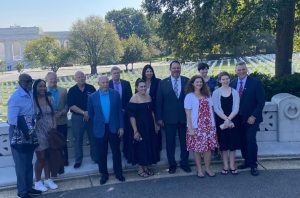
Two weeks ago—as part of the International Union of Elevator Constructors laying a wreath at the Tomb of the Unknown Soldier—I was honored to lead a group of men and women on a walking tour of our nation’s most hallowed ground. Throughout the day, our group paid tribute to those who served and sacrificed—Audie Murphy, James Parks, a masonry vault containing the remains of 2,111 soldiers gathered from the fields of Bull Run (Manassas, VA) and the route to the Rappahannock River, Robert Todd Lincoln, John F. Kennedy…and so many more. As always, it was a chance for reflection and humility.
These leadership tours of Arlington National Cemetery have become cherished moments for me. I am always looking forward to the next one.
Arlington National Cemetery is a place where every American can find solace and reflect on the achievements, selflessness, and lives of those buried there. The purpose of these tours is to not only pay homage to their memories but also to link experiences from the past to current day behaviors and principles – ultimately, helping to shape and develop leaders adept at learning from the lives of others.
Veterans Services Bugler, Laying a Wreath at Arlington National Cemetery, I shared reflections from this special day that will hold true for years to come:
The lessons we’ve learned from those who came before us are still alive today. These lessons are relevant to every individual who wants to improve his or her performance, both as a leader and as a follower. If you are interested in a customized Leadership Walking Tour of Arlington National Cemetery for your employees, organization, or family & friends contact Dixon Center for Military and Veterans Services.